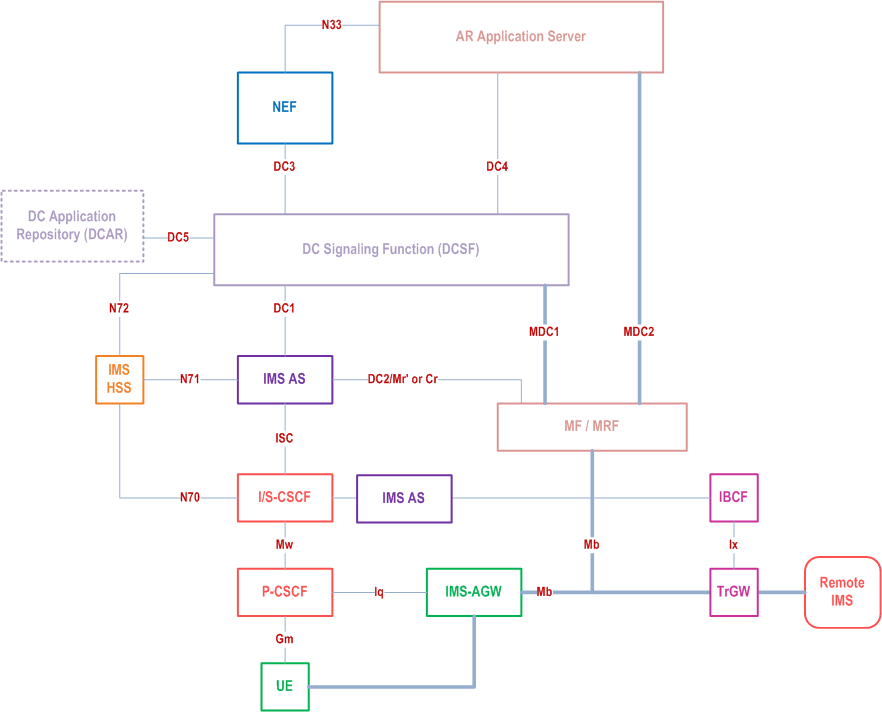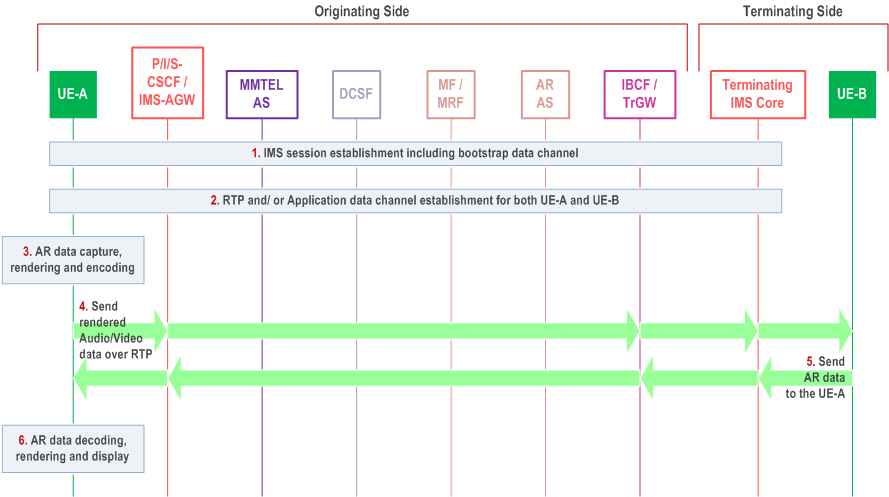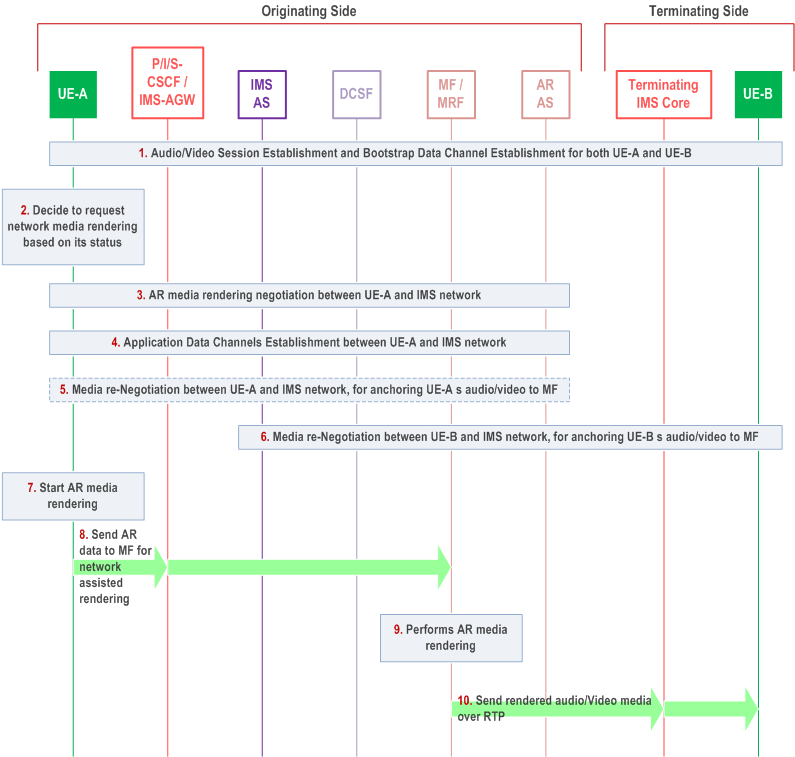Content for TS 23.228 Word version: 19.1.0
1…
3…
4…
4.2.4…
4.3…
4.4…
4.13…
4.16…
5…
5.2…
5.3…
5.4…
5.4.7…
5.4.8…
5.4a…
5.5…
5.5.3…
5.6…
5.6.3…
5.7…
5.7.3…
5.7.5…
5.7.8…
5.8…
5.10…
5.11…
5.11.3…
5.11.3.3
5.11.3.4
5.11.4…
5.11.5…
5.11.5.3…
5.11.6…
5.12…
5.16…
5.16.2…
5.19…
5.20…
A…
E…
E.2.2…
G…
G.5…
H
I…
J…
K…
L…
M…
M.3…
N…
P…
Q…
Q.2.5…
R…
S…
T…
U…
U.2…
V…
W…
X…
Y…
Z…
AA…
AA.3…
AB…
AC…
AC.7…
AC.7.2…
AC.7.2.2
AC.7.2.3…
AC.7.4…
AC.7.9…
AC.7.9.3…
AC.7.10…
AC.7.10.4.2…
AC.9…
AC.10…
AC.11…
AD…
AE…
AF…
AG…
AC.9 Support of AR Communication
AC.9.1 General
AC.9.2 Architecture
AC.9.2.1 UE Centric AR Communication
AC.9.2.2 Network Centric AR Communication
AC.9.3 Procedures
AC.9.3.1 UE Centric Procedure
AC.9.3.2 Network Centric Procedure
...
...
AC.9 Support of AR Communication p. 407
AC.9.1 General p. 407
This clause describes the enhancements to the IMS architecture supporting data channel services to additionally support AR services. Two modes for AR services are supported: UE centric and network centric.
AC.9.2 Architecture p. 408

To support AR communication, the data channel architecture is enhanced as follows:
AR Application Server (AR AS):
- The AR Application Server is responsible for AR service control related to AR communication, including AR session media control, AR media capability negotiation with the UE.
- The MF supports AR media processing. It receives and stores AR service media handling logic from the AR AS, and provides Augmented Reality MF capability based on the AR data received from UE.
- The IMS AS receives the media control instructions from the DCSF and accordingly interacts with the UE for connecting the UE's audio/video media termination to the MF.
- DC4: Reference point between the AR Application Server and the DCSF for AR service handling and AR session media control. This is out of scope of this Release.
- DC2: Service based reference point between the IMS AS and the MF for AR media resource management.
- MDC2: Reference point between the AR Application Server and the MF for transmission of application data channel traffic.
- Mb: Reference point used for IMS media transport and AR media transmission.
AC.9.2.1 UE Centric AR Communication p. 409
For the UE centric case, AR traffic is transparent to the IMS network and is exchanged between the two peer UEs via the deployed media functions (e.g. IMS AGW/TrGW).
AC.9.2.2 Network Centric AR Communication p. 409
Multiple realization alternatives for network assisted AR are available depending on device capability and what requirements the AR application has on the media transport protocol used between the UE and the network assisted AR function. AR services can be delivered via the following mechanisms:
- The AR application server provides network assisted rendering by having all AR media being transported using an established application data channel between the UE and the AR application server. This scenario represents a standard P2A/A2P data channel application as per clause AC.7.2 and consequently not requiring any further description.
- An IMS Media Function (MF) having the Augmented Reality media function capability, provides required network assisted AR media processing.
AC.9.3 Procedures p. 409
AC.9.3.1 UE Centric Procedure p. 409

Figure AC.9.3.1-1 depicts a typical call flow procedure to establish a UE centric AR IMS session from UE-A perspective. The main steps in the call flow are as follows:
Step 1.
UE-A initiates an IMS communication with UE-B, including establishment of bootstrap data channel.
Step 2.
The user of UE-A upgrades the IMS session with AR experience.
UE-A initiates a re-INVITE adding media descriptors required by the AR application to be established E2E, e.g. RTP and/or application data channels. Application data channel may be anchored in the MF.
In this scenario, the UE performs AR media rendering based on the AR data from its local application.
Step 3.
UE-A captures the AR data, performs AR media rendering locally and then encodes AR media e.g. audio/video media stream.
Step 4.
UE-A sends the AR media to UE-B through the established media connection(s).
Step 5.
UE-A receives the AR media from UE-B through established media connection(s).
Step 6.
UE-A decodes the AR media and performs AR media rendering locally and displays it on its screen.
AC.9.3.2 Network Centric Procedure p. 410
Figure AC.9.3.2-1 depicts an example for a call flow procedure to establish a network centric AR IMS session from UE-A perspective with rendering in the network for one of the UEs (UE-A) involved in AR communication. The main steps in the call flow are as follows:

Step 1.
AR Media Rendering Negotiation Procedure:
The UE-A initiates an IMS session and establishes audio and video session connections with the UE-B. The bootstrap data channel(s) are established at the same time for both the UE-A and UE-B.
Step 2.
Networking Centric Procedure:
The UE-A decides to request network media rendering based on its status such as power, signal, computing power, internal storage, etc.
Step 3.
The UE-A finishes AR media rendering negotiation with the AR AS.
Step 4.
If the negotiation result is successful in step 3, the UE-A initiates new P2A application data channels, which are used for AR data transmission between the UE-A and the network. During the P2A application data channel establishment procedure, the DCSF will instruct the MF via IMS AS how to establish the data channel and corresponding media processing specification.
Step 5 (Optional).
IMS AS initiates a Media re-Negotiation request with UE-A, to connect UE-A's audio/video media stream to MF.
Step 6.
IMS initiates a Media re-Negotiation request with UE-B, to connect UE-B's audio/video media stream to MF.
The UE-A can request to change the network rendering content if the status changed in the UE-A, such as low power, low computing power, etc.
Step 7.
The UE-A captures AR data and sends AR data to MF for network assisted rendering.
Step 8.
Based on the AR data received from the UE-A and/or instructions received from the AR AS, the MF performs AR media rendering according to the negotiation result in step 3.
Step 9.
The MF sends the rendered audio/video media stream to the UE-B.